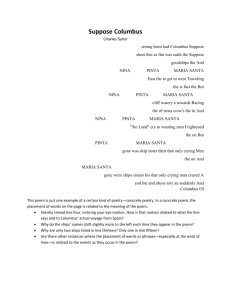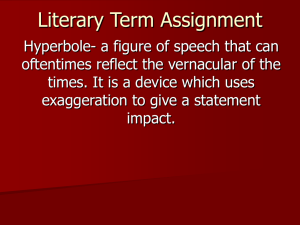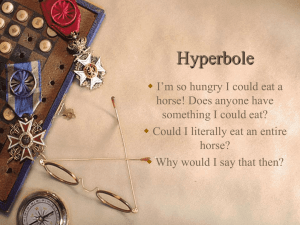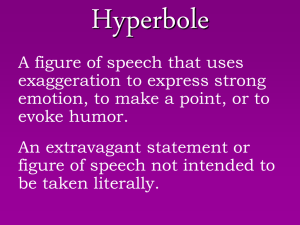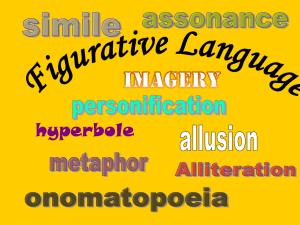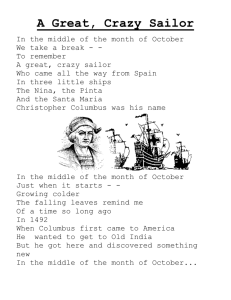10_14_2013-Use-the-news
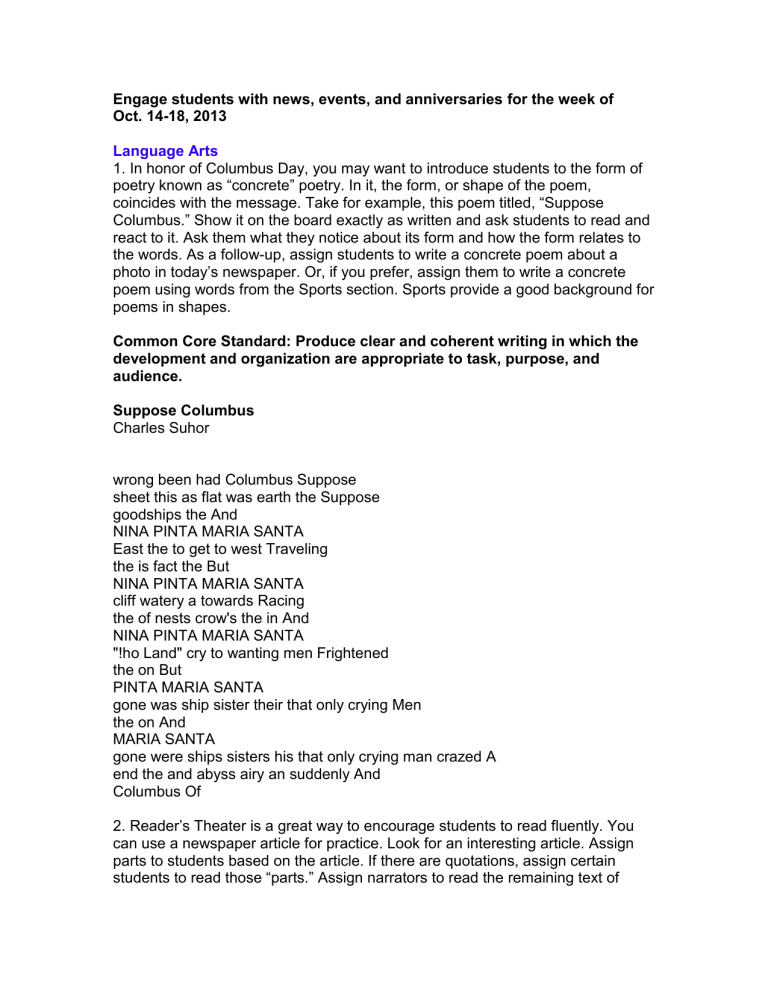
Engage students with news, events, and anniversaries for the week of
Oct. 14-18, 2013
Language Arts
1. In honor of Columbus Day, you may want to introduce students to the form of poetry known as “concrete” poetry. In it, the form, or shape of the poem, coincides with the message. Take for example, this poem titled, “Suppose
Columbus.” Show it on the board exactly as written and ask students to read and react to it. Ask them what they notice about its form and how the form relates to the words. As a follow-up, assign students to write a concrete poem about a photo in today’s newspaper. Or, if you prefer, assign them to write a concrete poem using words from the Sports section. Sports provide a good background for poems in shapes.
Common Core Standard: Produce clear and coherent writing in which the development and organization are appropriate to task, purpose, and audience.
Suppose Columbus
Charles Suhor wrong been had Columbus Suppose sheet this as flat was earth the Suppose goodships the And
NINA PINTA MARIA SANTA
East the to get to west Traveling the is fact the But
NINA PINTA MARIA SANTA cliff watery a towards Racing the of nests crow's the in And
NINA PINTA MARIA SANTA
"!ho Land" cry to wanting men Frightened the on But
PINTA MARIA SANTA gone was ship sister their that only crying Men the on And
MARIA SANTA gone were ships sisters his that only crying man crazed A end the and abyss airy an suddenly And
Columbus Of
2. Reader’s Theater is a great way to encourage students to read fluently. You can use a newspaper article for practice. Look for an interesting article. Assign parts to students based on the article. If there are quotations, assign certain students to rea d those “parts.” Assign narrators to read the remaining text of
each paragraph. Once parts are assigned, let the reading begin. This lesson adapts well to SmartBoard use. You can enlarge the text so that everyone can see. Once the reading is finished, discuss the content of the story with the class.
You may want to allow time for students to reread the story silently.
Common Core Standard: Read on-level prose and poetry orally with accuracy, appropriate rate, and expression on successive readings
3. News reporters write for a living. Your students can practice their writing skills by imagining themselves as reporters. First, have them choose an interesting news story and read it carefully. Ask them to imagine five questions the reporter might have asked in interviewing for that story. Then, students can go online to this interactive game that walks them through the steps of reporting a news story.
Common Core Standard: Cite the textual evidence that most strongly supports an analysis of what the text says explicitly
4. Visit this site where children's authors have been interviewed. Click on the video for Daniel Kirk. Have students pay special attention to the first question about how he finds characters. Then send students into the newspaper searching for someone in an article who would make a good character for a story, based on how he or she reacted to the events in the news story. Students should write a character sketch about that person. And, if your students ever need a good prompt for writing, they can use the ones offered at this site .
Common Core Standard: produce clear and coherent writing
Math
1. It may be interesting for students to consider how math is relevant in the real world. Invite them to review the Help Wanted ads and to identify the jobs that require math skills. Have them write about what their research reveals. What percentage of the total jobs listed require math?
Common Core Standard: Find a percent of a quantity
2. There is lots of math found in any day’s newspaper. Invite students to go on this scavenger hunt. They should write about each of these as they find it:
A decimal number
A three-digit number
Any number
A prime number
3. After they find each one, they should use the numbers in this way. First multiply the decimal by the three-digit number. Divide the product by the next number they found. Then have them subtract the prime number.
Common Core Standard: Find whole-number quotients of whole numbers with up to four-digit dividends and two-digit divisors, using strategies based on place value, the properties of operations, and/or the relationship between multiplication and division. Illustrate and explain the calculation by using equations, rectangular arrays, and/or area models.
Science Literacy
1. Tell students that the first manned flight took place in a hot-air balloon in
France on October 15, 1783. Of course, over time manned flight evolved to air transport as we know it today. Challenge students to find a spectacular invention in today’s news and find out when it was created. They should write about its inception and then detail how it is being used today, as shown in the newspaper.
Common Core Standard: Develop a topic with relevant facts, definitions, concrete details, quotations, or other information and examples
2. Explain to students that people in Denmark now pay a bit more money if they choose to eat some fattening foods. The country instituted a “fat tax” based on the amount of saturated fat used in preparing the food. For example, a bag of chips might cost about 12 cents more while a hamburger goes up about 40 cents.
This
“fat tax” may have been the first of its kind in the world. Ask students to use the archive tool of the eedition to search “fat tax” to see if they can find any articles about this. Then allow time for a discussion about whether students think a government should tax people in order to encourage them to eat healthier foods.
Common Core Standard: evaluate conclusions in science text
Social Studies
1. On Oct. 16, 1968, there was a protest of sorts at a medal ceremony of the
Olympics. U.S. winners Tommie Smith and John Carlos raised their fists, clothed in black gloves, during the singing of the national anthem. The gesture was meant as a protest against racial inequality. It was extremely controversial. Tell students about the incident and allow time for a discussion of the efficacy of protesting. They may want to use the archive tool to check the stories about recent protests about the government shutdown. Have them skim or read the articles to learn important facts about this protest and to talk about what they read.
Common Core Standard: examine key ideas in text
2. Travel writer Eugene Fodor was born Oct. 14, 1905. Have students imagine he time traveled to today and read your newspaper. What activities might he find to do for fun? Have students write a travel journal entry detailing the fun things to do in your area, based on what’s in the newspaper.
Common Core Standard: Write informative/explanatory texts to examine a topic and convey ideas, concepts, and information through the selection, organization, and analysis of relevant content.
3. The Nobel Prizes were announced throughout last week. The history of the prizes is interesting. Share the story with students. Alfred Nobel died in 1895. He left a will which stated, in part, that his money should be given out as prizes for
"the person who shall have done the most or the best work for fraternity between
nations, for the abolition or reduction of standing armies and for the holding and promotion of peace congresses." Prizes are awarded in a variety of fields each year. The 2013 literature winner, Alice Munro, learned of her win from a message left on her phone. Challenge students to watch the news to learn other facts about this year’s winners. What do students think of Nobel's choice to give his money away in this fashion? Why would someone make that choice?
Common Core Standard: examine key ideas in text
WRITE THE NEWS LESSON
Topic: Hyperbole
Hyperbole (pronounced hahy-PUR-buh-lee)is a type of figurative language, used to make comparisons or to describe something. It’s different from simile and metaphor because hyperbole is an exaggeration. It’s not meant to be taken literally.
You might exclaim, “These books weigh a ton!” But your books don’t actually weigh 2000 pounds. You’re using hyperbole to describe the books as heavy.
Here are other examples of hyperbole:
It’s so hot you could fry an egg on the sidewalk.
I’ve told you a million times not to exaggerate.
I’m so hungry I could eat a horse.
She ran faster than the speed of light.
Write an example of hyperbole for each:
Describe a thin person.
Describe an old item.
Describe something happening quickly.
Can you find any headlines that are examples of hyperbole?
Common Core Standard: develop and strengthen writing as needed by planning, revising, and editing
